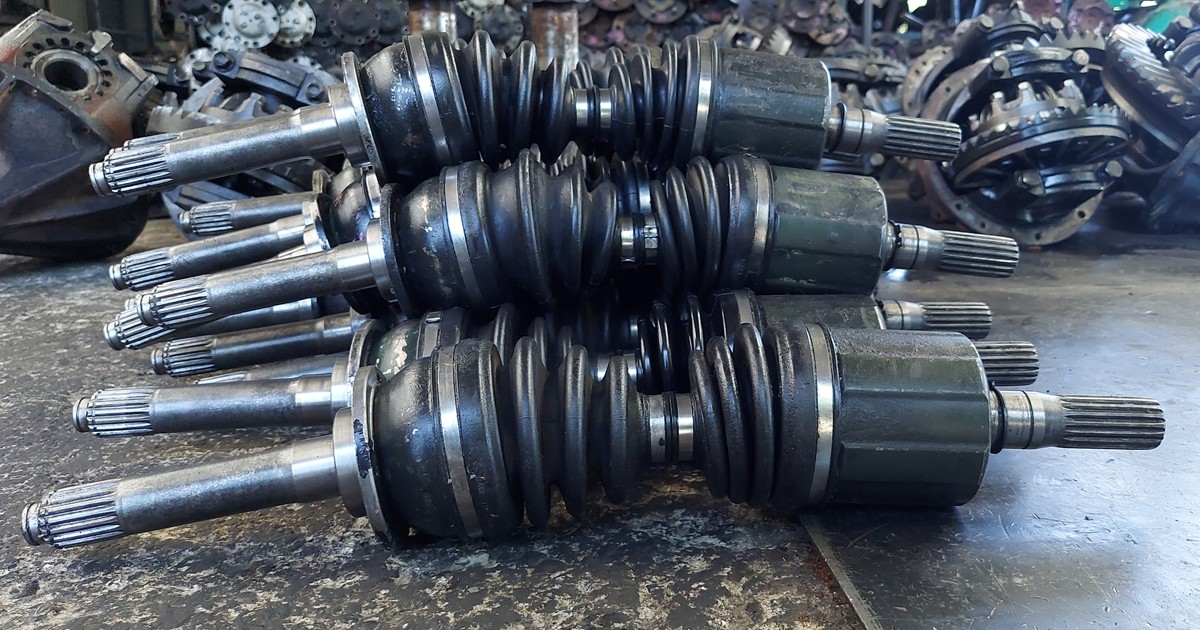
A driveshaft (also called a propeller shaft or Cardan shaft) is a lengthened ring-shaped shaft, customarily built of steel that goes from the engine to gears, allowing the wheels to spin. The pistons inside the engine shift their power to a set of gears, moving the drive shaft, generating torque. The torque then goes through the driveshaft to wheel gears, causing them to rotate. It is how a vehicle runs on the road.
It is crucial to ensure the flexibility of the shaft assembly since drivetrain axles shake up and down and move sideways when you brake and accelerate. The driveshaft assembly contains the propeller shaft, universal joints, slip splines and yokes.
How does the driveshaft work?
It is vital to know that front-wheel-drive vehicles don’t possess drive shafts. Here, the transmission and axle join into one unit known as a transaxle. On the other hand, the transmission and axle are two isolated components in four-wheel and rear-wheel-drive vehicles. Here the driveshaft shifts the rotary motion of the transmission to the axle.
The driveshaft features a tubular design and is generally created from aluminium, steel or carbon fibre to ensure it remains robust and lightweight.
The majority of cars and trucks employ a straight-line or firm driveshaft to spin the wheels. You require gearing to switch the path of power (or torque) from a straight line to a rotary line of power delivery.
The front-engine, rear-wheel cars use a lengthier drive shaft to transmit power to the rear wheels. The opposite relates to rear-engine, front-wheel-drive vehicles. Either way, most driveshafts employ a U-joint to let it flex with road limitations (jolts and dips) to sustain tire and vehicle steadiness.
What are different types of driveshafts?
The type of drivetrain your vehicle has would tell the kind of driveshaft it comes with. You must be aware that we usually have rear-wheel drive, four-wheel drive and front-wheel drive vehicles.
Rear-wheel drive (RWD)
In a front-engine, RWD vehicle, the power goes to the rear wheels. These cars have a long driveshaft linked to the transmission at one side and the differential on the other side by universal joints.
Four-wheel (4WD) or all-wheel drive (AWD)
On a usual four-wheel-drive or all-wheel-drive car, we find two driveshafts. One is the same as you see in a rear-wheel-drive vehicle, and the other is present at the front. It links to the front differential and the transfer case by u-joints.
Front-wheel drive (FWD)
In a front-wheel-drive vehicle, the engine's power goes to the front wheels, so there is no need to have a long driveshaft. The FWD vehicles have all the drivetrain components in the front and employ constant velocity joints instead of universal joints.
7 Common Signs of a Failing Driveshaft
You should know that the driveshaft by itself rarely stops working. However, owing to unnecessary pressure and deterioration, it will ultimately show symptoms of failure.
A failing driveshaft will make it hard for you to control the vehicle. Let’s learn about signs of a flawed driveshaft. If you witness any of these symptoms, immediately visit your mechanic. They have the knowledge to identify and repair all kinds of driveshaft issues.
1. Intense vibrations and shuddering
Vibrations and shuddering from under the vehicle are the two most conventional symptoms of a failing driveshaft. When the U-joint, couplers or carrier bearings wear out, you can feel undue driveshaft vibration. It could also be due to loose bolts on the driveshaft or an unbalanced unit. If you fail to repair these driveshaft parts, they can further harm other drivetrain components.
2. Strange noises
Odd noises could be another sign of a worn-out driveshaft. When the bearings and bushings, holding the driveshaft and U-joints, give up or rundown, they influence the driveshaft’s competence to rotate normally. It results in noises like scraping, squeaking, clanking and rattling. Whenever you hear any of these sounds, pay a visit to your mechanic.
3. Feel shuddering as you accelerate
If you feel shaking while accelerating from a stop or low speed, it could indicate a failing driveshaft. A worn carrier bearing or loose U-joint could be the culprit, requiring you to visit a mechanic as early as possible.
4. Difficulty Turning
If you feel difficulty making turns, it could be due to a u-joint problem. A worn u-joint may inhibit the wheels from turning correctly, making it hard to manoeuvre the vehicle.
5. Loud clunking noise
If you hear a noisy clunking sound while shifting, know there is a problem with the driveshaft. The probable cause is a worn u-joint.
6. Squeaking noise
Not only irritating, but a squeaking sound at low speeds can also be due to the u-joint that requires lubrication. Applying a tiny amount of grease will prevent the squeaking noise. However, if the u-joint is excessively worn, you have to change it altogether.
7. Clicking or knocking noise
It could be due to a worn or faulty CV joint. Visit your mechanic for diagnosis and proper repair.
A driveshaft is the central part of your vehicle's drivetrain. Any problem with it will significantly mar the drivability and performance. Addressing the issues earlier is key to having a safe drive. If you experience any signs of a faulty driveshaft, you should immediately consult with an expert technician for repair.


